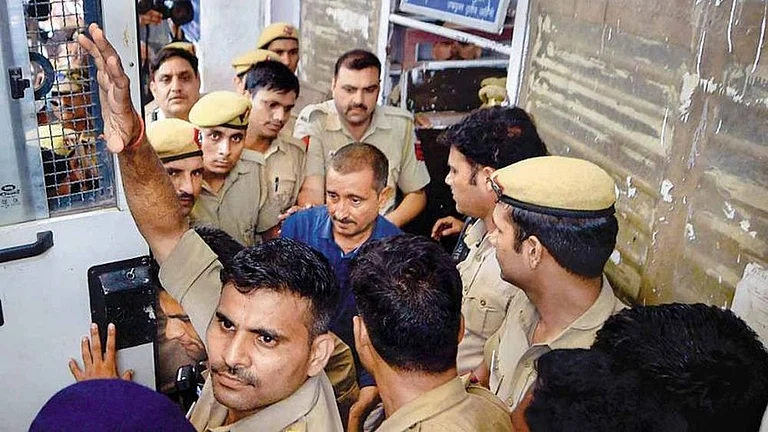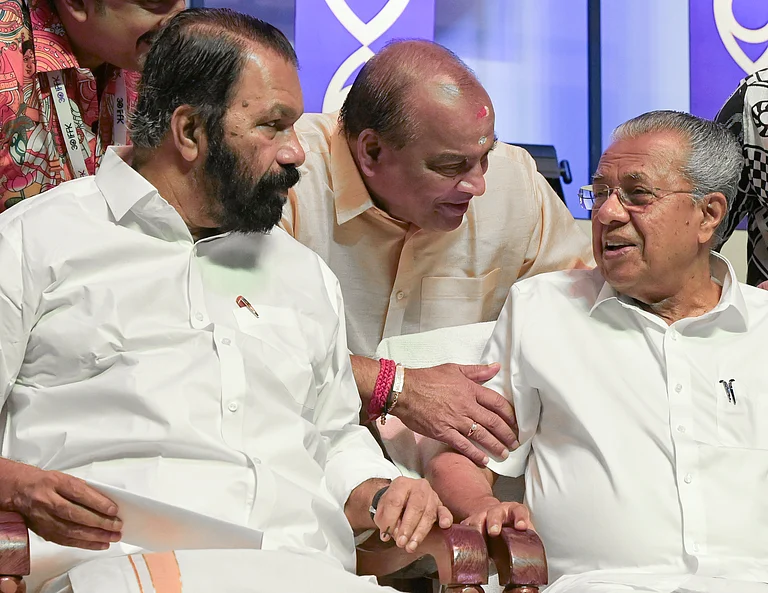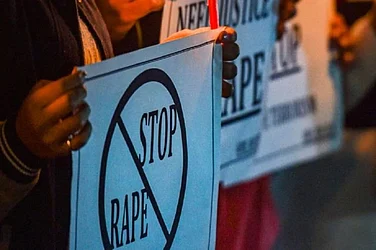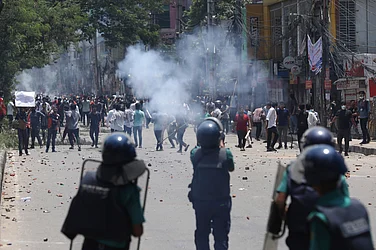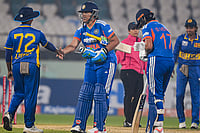These men and women are what’s left of a struggle that involved tremendous sacrifices, whose significance has only become more profound over time. Fighters of the anti-colonial resistance against British Raj, they do not just form the bedrock of our national ethos, but also represent a set of values that can still guide the way in our collective strivings to live the freedom they once fought for. And on Gandhi’s 71st death anniversary, they spell out the independent India he, and they, dreamt of.

Gopal Singh, Patiala
Sitting on a floral fleece throw on an armchair at his home in Patiala, sunlight gushing in through the windows, Gopal Singh, 93, recalls how he and fellow inmates were made to sleep on date palm leaves in Lahore jail. Singh was only 17 in 1942 when he was arrested for shouting slogans against the government of British India and had to spend 10 months in jail for refusing to apologise for his act of defiance. “The jails were packed that year,” he recalls.
Born in 1925 in Motra village of undivided Punjab’s Sialkot district, he had to leave his home and go to Sirhind on foot during Partition in 1947. “There were 60 of us. A group of 40 who preceded us were butchered at Saidan, Alipur. We had to cross their corpses,” says Singh, adding that a detachment of the army’s Maratha regiment saved their lives. He was accompanied by his aunt during the forced migration as his parents had passed away earlier. The aunt-nephew duo reached newly independent India empty-handed, hoping their migration was temporary and that they would return to their village in a few days.
For the first three years after Partition, Singh worked as a labourer, earning Rs 3-4 a day. He was then allotted a plot in Patiala’s Dakaunda village. The official had asked him to choose between a good house and good agricultural land. He chose the latter, toiling hard along with his four bulls and a camel to rebuild his life. Decades later, he bought a second-hand jeep that he drove until his mid-80s. Now he lives at his son’s house in Patiala city and rarely goes out. When he does, there are only two places he visits—the gurudwara sahib and his fields.
Singh has been to Pakistan thrice in recent decades. Recalling his visit to his native village, he says, “The whole village gathered upon my arrival. ‘Look, a sardar who used to live here has come from India,’ they said.” Their old house had been razed down and a new one built in its place. He met a few old friends on his first visit, but there were none left during his third.
So, is this the independent India he dreamt of? “We never thought about it,” he says. “All we knew was that the British had enslaved us and, once we win independence, the oppression would stop.” His 62-year-old son quips, “Somewhat like the way we keep hoping for ‘achchhe din’ (good times).”

Shaukat Ali Hashmi, Delhi
The dark alleyway of Gali Mochiyan in Old Delhi’s Chitli Qabar Bazar, with rusted iron pipes and crusted walls, and two-wheelers lining both sides, leads to the house of Shaukat Ali Hashmi. Sitting on one of the scooters is a boy, no more than 16, with golden streaks in his hair, a Sultanate-era beard chiselled to a pointed front, and velvet shoes. He shows the way to the 97-year-old freedom fighter’s house at a cul de sac, which the sun somehow manages to illumine. Hashmi’s son places a plastic chair for him, and the frail nonagenarian rises from a divan and eases into the chair.
The kurta-clad gentleman recalls that he wasn’t even 20 when he joined the freedom struggle. His organisation, the Jamiat Ulema-e-Hind (JUH), had lent political support to the Congress in its fight against British colonialism. “The Ulema said that being subject to British rule is proscribed as per Islamic teachings and so one must rebel against it,” says Hashmi. Mahatma Gandhi had given a call for civil disobedience and, Hashmi says, one freedom fighter was courting arrest every day by raising the Indian flag and shouting slogans against the government. “We’d meet secretly, discuss plans, get pamphlets printed, etc. Once the government sent a man from the CID to follow me, and I told him, ‘I’ll tell you when and where I’ll shout subversive slogans. You don’t have to follow me.’ The official replied that it was his duty to follow him. There were times when I managed to dodge him,” he recounts.
One day towards the end of 1942, Hashmi had a guest who told him that the JUH leadership wanted him to court arrest. Apprehensive that somebody might tip off the CID and he might be arrested in the night before the appointed day, the 21-year-old spent that night at a friend’s house. In the morning, he left to meet a senior JUH leader and then went to Jama Masjid with some youngsters from the locality. The flag was folded and kept in a pocket. At the designated place, he took out the flag and unfurled it, shouting slogans against the British government. Within five minutes, he was arrested and taken to Daryaganj police station.
“I openly admitted at the trial that I had shouted the slogans, and said I’d keep on doing so until the British left the country,” says Hashmi, who was sentenced to six months in prison. His father, a supporter of the Muslim League who disagreed with his politics, met him in jail. “He told me, ‘Son, don’t ever apologise.’”

Nagalingam Shanmugam, Chennai
He hopes he would have little use for the whitener at least for the next few years. In the past one year, Nagalingam Shanmugam has had to whiten out the names of two office-bearers from the letter pad of the ‘All India Azad Hind Fouj Association (TN HQ)’, a group of former veterans of the Indian National Army (INA) founded by Netaji Subhash Chandra Bose. “The two died of age-related illness. Most of us are in our late 80s or 90s, and staying healthy is the biggest challenge now,” says this 90-year-old veteran who served in the INA as a civilian volunteer in Burma in the 1940s and is the secretary of the Tamil Nadu unit that operates out of a small office in Red Hills, an outer suburb of Chennai. Most INA veterans in Chennai have been living in and around Red Hills since they were shipped out of Burma as refugees in the 1960s.
Clad in a starched white dhoti and shirt, a tricolour towel draped on his shoulder and sporting a Gandhi cap, with his flowing white beard and holy ash smeared on his forehead with a kumkum in the middle, Shanmugam could pass off as a spiritual leader. “I am very religious. Most of us in the INA were. Being religious taught us discipline. Like getting up early, having a bath and doing our prayers before starting our work of organising supplies for the INA and going house to house collecting funds,” recalls Shanmugam.
Born to a Tamil father who had migrated to Burma, Shanmugam was 17 when he listened to Bose at the Jubilee Hall in Rangoon calling Indians to give their blood and win their freedom. “My friends and I were electrified by the speech and enlisted as civilian volunteers for the INA. We were given basic training in self-defence, but our job was to mobilise funds and supplies to the combat units of the INA,” he says. Collecting funds was the easier part as there were more than five lakh Tamils and a large number of Gujaratis in Burma, who were more than willing to give away their savings, gold and even cattle. Aiming to cut off the supply of money and material to the INA, the British jailed hundreds of volunteers like Shanmugam. “We spent six months in jail in 1945. It was monsoon time and our biggest enemies in prison were leeches and mosquitoes. Only after we were released did we hear about Bose’s disappearance, but we refused to believe it. We saw it as a ploy by the British to weaken the INA, which, by then, had been reduced to a shadow of itself. We had little choice but to back to our schools and fields,” Shanmugam says.
A bigger shock came in 1964 when Indians in Burma were stripped of their rights and belongings, and sent out of the country. After a few months at a refugee camp in Tamil Nadu, he settled down in the Red Hills area along with many other INA volunteers similarly deported. He lives a spartan life in a small two-storey house with one of his sons. He has two sons, two daughters, and is fit enough to use public transport for his association work.

Ranchhodbhai Shah, Ahmedabad
At 94, he is still fit and sound. “Gandhiji advocated a healthy body for a healthy mind,” says Ranchhodbhai Shah, a Gandhian who plunged into the freedom struggle in 1942 when he was 17. “I was in the higher secondary classes (then called intermediate), doing science, in Vadodara when the call for the Quit India movement was given in August that year. Our teachers also instilled in us the spirit of nationalism.” He left college and joined the movement, never to look back.
In his own eyes, however, his actual participation in the struggle started when he first went to jail. “In 1943, orders were issued to arrest freedom fighters. I was held in police custody at Leela Bungalow for two days, and then sent to the Vadodara Central Jail after my bail was refused,” he recalls. He spent four months in jail as a political prisoner, which, he says, only strengthened his determination to fight for freedom.
“I could never meet Gandhiji, but listened to him and also read him. I took up social service and later joined the Sarvodaya Ashram set up by veteran Gandhian Navalbhai Shah at Gundi village in Ahmedabad district,” he says. Shah now lives with his son, who retired from Canara Bank. Besides visiting Gandhian friends and institutions, Ranchhodbhai regularly reads half a dozen periodicals.
He says he has no complaints about his freedom fighter’s pension of Rs 10,000 a month. “This is the recent one introduced by (Gujarat’s first woman chief minister) Anandiben Patel. Initially, the pension was only Rs 500, which I had been getting for some 25-30 years, until then chief minister Chimanbhai Patel hiked it to Rs 6,000 in the 1990s,” he says.

G.G. Parikh, Mumbai
He vividly remembers when he became a “confirmed freedom fighter”. It was in 1942, when G.G. Parikh, now 94, was arrested as a 17-year-old teenager trying to stop trains at Mumbai’s Churchgate station, after picketing at St Xavier’s College. Those were the initial days of the Quit India movement. His arrest came close on the heels of the historic August 9 meeting where Mahatma Gandhi raised the ‘Do or Die’ slogan. Recalling his time at a temporary jail created at Worli in Mumbai, he says, “We were 18 people in a small room on the third floor. Some people were shouting slogans outside, but we couldn’t hear properly. When we tried to look out, we were beaten up. When I was thrashed, that was the moment I became a confirmed freedom fighter.” Parikh spent 10 months in jail and became not just a freedom fighter, but also a socialist.Earlier, at his Kanpur school, he had started a handwritten magazine and almost got rusticated, but managed to create a stir. It was at Mumbai’s St Xavier’s College that he was introduced to Marxism and became a student activist. “We formed the Students Congress, which was very active when the party leadership was in jail,” he says about the 1942-47 period. After studying medicine in Mumbai and becoming a doctor, Parikh never left the socialist cause. He was jailed eight times after Independence, with the Emergency (1975-77) sparking another defining struggle.

K.C. Narayanappa, Bangalore
It’s a windy day in Bangalore, but that doesn’t bother 92-year-old K.C. Narayanappa as he recollects old memories. “Everybody participated in the freedom movement voluntarily. There was a lot of support in all the villages. That was how it was,” he says. In the years leading up to 1947, Narayanappa, who is from a landed rural family in Doddaballapura, was a college student in Bangalore, about 70 km to the south. “I was the first graduate in my village,” he says. Subsequently, Narayanappa also started a Seva Dal unit in Doddaballapura, and went to jail. Last August, he was among those invited to the President’s reception for freedom fighters.
In 1944, there was a famine in the region. “We had no ration and no drinking water. We had to dig out tubers to eat,” says Narayanappa, who was a teenager at the time of the Quit India movement. Many leaders were imprisoned in Bangalore Central Jail during those days.
“Large crowds gathered when Nehru came to Bangalore, and also during General K.M Cariappa’s visit,” he says. “In those days, there was little consideration for money…. Now money, not principles or rules, runs everything. Sometimes, I feel gaining Independence has turned into a misfortune. Everyone got corrupted and nobody is safe.”
The nonagenarian continues to be sprightly. “I know every person in Doddaballapura, and I ride a motorcycle even now,” he says, offering his right hand for a firm handshake. “See, it’s strong.”

Subhadra Khosla, Delhi
Once, while she was studying in Lahore, Subhadra Khosla (born 1928) was asked to weave a piece using wool as part of a school activity. When she was through with the exercise, her father, Lala Achint Ram, also a freedom fighter and a Gandhian, asked her to bring it along with an oil lamp. “Yeh videshi hai (this is foreign material),” said her father and set it on fire. “Until the kids aren’t prepared for the struggle, how will we get independence?” She says she suffers from ‘khaddar ki beemari’ since then—in other words, she can only wear khadi, the homespun Indian cotton cloth. “What is there in the market does not even remotely affect us,” she says, sitting at her house in Delhi.
Khosla is from a generation that worked with the principle of sacrifice as the touchstone. When India became free in August 1947, she was not even 18. But she had already been to jail for her role in the freedom movement. On August 26, 1942, she joined her mother, younger sister and three other women at Lahore’s Anarkali bazaar and unfurled the Indian flag, and courted arrest. “My mother told the judge that she couldn’t keep going to jail again and again as she has to cook for her husband, so the British government should give us independence as soon as possible,” laughs Khosla, who narrates events from the trying time in jail with great relish. The jail in-charge often mocked at the kids, saying, “So these kids will wrest independence from the British!” and one of the women would respond, “When we are independent, you’ll come to us asking for jobs.”
While recollecting the memories of the freedom movement, she reminisces how the people then had ‘tyaag’ (sense of sacrifice) and ‘lalak’ (ardour). While talking about those times, she often breaks into a song. One of the songs goes:
Azaadi ke naaro se
Duniya ko hila denge
Soton ke kya kehne
Murdon ko jaga denge
Hum mulk ke bachche
Mulk ki khidmat mein
Bachchon ko kata denge
Ghar-baar luta denge....
Khosla’s father was one of the very first members of the Servants of the People society founded by Lala Lajpat Rai. Her family lived in Lahore’s Lajpat Bhavan. In 1947, when India bled during Partition, Khosla and her family hosted and served the uprooted families there. Her days would be spent serving chapatis to the survivors. In 1948, the family moved to New Delhi and Lala Achint Ram successfully contested general elections twice. Khosla’s brother, Krishan Kant, went on to become the vice-president of India in 1997. Her late husband was a commandant in the CISF.







